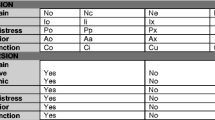Abstract
Objective
To evaluate the specificity, sensitivity, and accuracy of pain intensity assessments (0–10) conducted by registered nurses (RN) and clinical nurse assistants (CAN) as compared to those conducted by the palliative care consultant (PCC).
Patients and methods
We performed a retrospective review of charts of patients who had received palliative care consult between April 2002 and August 2002. Data on patient demographic, date of palliative care consult, and date and intensity of pain assessment were collected. A numerical rating scale from 0 (no pain) to 10 (worst pain) was used to assess pain intensity. The data were included for analysis if the pain intensity assessment was performed during the same shift by all three care providers (RN, CNA, and PCC).
Results
Forty-one charts were found to include a complete pain assessment performed by the RN, CNA, and PCC. The agreement of pain intensity between the PCC and both the RN and CNA was poor. For a diagnosis of moderate-to-severe pain, the RN’s intensity assessment had a specificity of 90% but a sensitivity of 45%, and the CNA’s intensity assessment had a specificity of 100% but a sensitivity of only 30%. The Spearman correlation coefficient between the intensity assessments performed by the PCC and the RN was 0.56 (p=0.00) and between those by the PCC and the CNA 0.22 (p=0.15).
Conclusion
Lack of agreement between pain intensity assessments performed by the PCC and bedside nurse suggests possible inconsistencies in the way the assessments were performed. Better education on how to perform standard pain intensity assessment is needed.
Similar content being viewed by others
References
Anderson K, Cleeland C (2003) The assessment of cancer pain. In: Bruera ED, Portenoy RK (eds) Cancer pain: assessment and management. Cambridge University Press, New York, pp. 51–66
Zhukovsky D, Gorowski E, Hausdorff J, et al (1995)Unmet analgesic needs in cancer patients. J Pain Symptom Manage 10:113–119
American Pain Society Quality of Care Committee (1995) Quality improvement guidelines for the treatment of acute pain and cancer pain. JAMA 274:1874–1880
Cohen MZ, Easley MK, Ellis C, et al (2003) Cancer pain management and the JCAHO’s pain standards: an institutional challenge. J Pain Symptom Manage 25:519–527
Philips DM (2000) JCAHO pain management standards are unveiled. JAMA 284:428–429
Alcenius M (2004) Successfully meet pain assessment standards. Nurs Manage 35(3):12
Miller DH (1992) Complying with Joint Commission nursing standards: practical documentation tools. J Healthc Qual 14:24–29
O’Connor M (2003) Pain management: improving documentation of assessment and intensity. J Healthc Qual 25:17–21
Eder SC, Sloan EP, Todd K (2003) Documentation of ED patient pain by nurses and physicians. Am J Emerg Med 21:253–257
Cleeland CS, Reyes-Gibby CC, Schall M, et al (2003) Rapid improvement in pain management: The Veterans Health Administration and the Institute for Healthcare Improvement Collaborative. Clin J Pain 19:298–305
Chang VT, Hwang SS. Feuerman M (2000) Validation of the Edmonton Symptom Assessment Scale. Cancer 88:2164–2171
Bruera E. Kuehn N. Miller MJ. Selmser P. Macmillan K (1991) The Edmonton Symptom Assessment System (ESAS): a simple method for the assessment of palliative care patients. J Palliat Care 7(2):6–9
Cancer-pain-treatment guidelines for patients (2001) National Comprehensive Cancer Network. Version1, January 2001
Briggs M. Dean KL (1998) A qualitative analysis of the nursing documentation of post-operative pain management. J Clin Nurs 7:155–163
Coyne ML, Smith JFH, Stein D, Hieser MJ, Hoover L (1998) Describing pain management documentation. Medsurg Nurs 7:45–51
Idvall E. Ehrenberg A (2002) Nursing documentation of postoperative pain management. J Clin Nurs 11:734–742
Jenkins CA. Schulz M. Hanson J. Bruera E (2000) Demographic, symptom, and medication profiles of cancer patients seen by a palliative care consult team in a tertiary referral hospital. J Pain Symptom Manage 19:174–184
Reyes-Gibby CC, McCrory LL, Cleeland CS (2003) Variations in patients’ self-report of pain by treatment setting. J Pain Symptom Manage 25:444–448
Kaasalainen S, Crook J (2003) A comparison of pain-assessment tools for use with elderly long-term-care residents. Can J Nurs Res 35:58–71
Costello P, Wiseman J, Douglas I, et al (2001) Assessing hospice inpatients with pain using numerical rating scales. Palliat Med 15:257–258
Rosier E, Iadarola M, Coghill R (2002) Reproducibility of pain measurement and pain perception. Pain 98:205–216
Forouzanfar T, Kemler M, Kessels A, Koke A, van Kleef M, Weber W (2002) Comparison of multiple against single pain intensity measurements in complex regional pain syndrome type I: analysis of 54 patients. Clin J Pain 18:234–237
Jensen MP (2003) The validity and reliability of pain measures in adults with cancer. J Pain 4:2–21
Au E, Loprinzi CL, Dhodapkar M, Nelson T, Novotny P, Hammack J, O’Fallon J (1994) Ragular use of a verbal pain scale improves the understanding of oncology inpatient pain intensity. J Clin Oncol 12(12):2751–2755
Gordon DB, Pellino TA, Miaskowski C, McNeill JA, Paice JA, Laferriere D, Bookbinder M (2002) A 10-year review of quality improvement monitoring in pain management: recommendations for standardized outcome measures. Pain Manag Nurs 3(4):116–130
Oxman TE (1998) Effective educational techniques for primary care providers: application to the management of psychiatric disorders. Int J Psychiatry Med 28(1):3–9
Oxman TE, Dietrich AJ, Williams JW Jr, Kroenke K (2002) A three-component model for reengineering systems for the treatment of depression in primary care. Psychosomatics 43(6):441–450
Author information
Authors and Affiliations
Corresponding author
Rights and permissions
About this article
Cite this article
Bruera, E., Willey, J.S., Ewert-Flannagan, P.A. et al. Pain intensity assessment by bedside nurses and palliative care consultants: a retrospective study. Support Care Cancer 13, 228–231 (2005). https://doi.org/10.1007/s00520-004-0692-4
Received:
Accepted:
Published:
Issue Date:
DOI: https://doi.org/10.1007/s00520-004-0692-4




